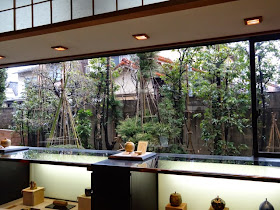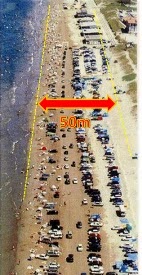推理小説で、全知の視点でない場合、展開が難しいのですね。
しかもこの場合視点が名探偵でなく、ただのお嬢さんにあるのですから、なお一層困難な設定です。
ですが、視点が彼女であることがこの話の魅力になり、読者の興味をひくのです。
暗い面やつらい話を登場人物の中で一番清らかさがある彼女の目を通すからこそ、読者は精神的負担が少なく、読み進めることができるのです。
禎子は、風貌が美しく、比較的若く、純情な性格に描かれていますが、可憐な感じはなく、寧ろいつも冷静で、おろおろしたところがありません。
彼女は、知り得たことがはっきりするまでは自分の胸にとどめておきます。
身近に殺人がおきてさえも、心の不安を吐き出すこともしませんし、刑事に対しても思い当たる事柄を話そうともしません。
殺人犯に対しての怯えや憎しみよりもその心情に同情できる懐の深さがあります。
最後に犯人を追い詰めるというよりも、犯人の幸せを守るために、危険な雪道にタクシーを走らせます。
推理小説として推理部分が不完全でも、話がおもしろければ、完全であっておもしろくないものよりも、好まれると私は思います。
人間にしても、他の芸術作品にしても、それは言えます。
この小説は推理の部分よりも、人間ドラマに重きがあるのです。
少なくとも私は、そう理解しました。
Human Drama
I
wrote earlier that I have now first read Seichou
Matsumoto's work: "Zero Focus".
My first impression is that this story's mystery parts are weak, I think one of my reasons was my prior information was too strong about this book as a mystery novel.
"About
1958, a main character Teiko got married with Kenichi Uhara who then
suddenly disappeared.
While
she looked for him she finds out about his past which she did not
know about before."
I
felt that all the writing, progress of the story and the characters
are steady and calm.
Before
the disappearance, there are some advance hints and the nature of the
descriptions anticipate and set the mood for the future in a common
way, however,
I felt they are very good.
The
story continues slowly, the development is not dramatic.
Without
clear evidence her reasonings keep developing and there is no
great detective.
Often
makers use Hollywood films' methods which make a story develop
quickly, this story does not which impressed me favourably.
However,
surely this story made me wonder if this is a mystery novel.
I
am not fan of mystery, although I have read or seen a few mystery world things, so I found the culprit relatively early.
Therefore shocking
turns of events did not happen for me which the main character experienced or the author planned.
Teiko
gets new information, later they are repeated, I felt disappointed, even
though the repetitions are in different ways.
This
is because the novel was first serialized for a magazine, so maybe
the author tried to keep the
reader's understanding or avoid confused memories.
And
perhaps because of regular deadlines he did not have enough time, so
he might pad it out.
I
think nowadays when a serialized story becomes a book : "Tankōbon" in Japan, these problems
are repaired and the book becomes shorter.
The
main character's conjectures or solutions depend on her intuition, so
after the reading I do not feel fine, because there is a lack of the
clear facts and still some doubts.
I
do not think I do not believe intuitions, though the word is used too often, so
every time it
comes which becomes obnoxious.
I could not believe her conjectures, so I was not misled (red
herrings).
I
think in mystery novels, a development of a story is difficult if the
point of view is not omniscience, isn't it?
Moreover
in this cace, the viewpoint is not a great detective, just a
young lady.
However,
this is, indeed, this story's attractiveness and holds the reader's interest.
The
dark aspects and hard things are looked at through her eyes and she is the most pure person in this story, so they are not burdensome to the
reader and the reader can continue to read.
The
main character,Teiko is good looking, represents a comparatively
young and pure personality, however, she is not sweet, but rather always cool and does not get flustered.
She
kept her findings to herself until she felt sure.
Even
though murders were close to her she did not talk out of
her anxiety and did not tell information to a police detective.
She
is broad-minded in that she sympathized with the murderer rather
than being frightened or feeling hatred.
In the end she tried to help the murderer's happiness even asking her taxi to take
a hazardous snowy mountain road rather than punishing the murderer.
Even
if the reasoning is not perfect as a mystery, the story could be amusing and then the story is welcome to readers, rather than a mystery novel in which the reasoning is perfect but is not fun.
I
can say this is the same for people and art works.
In
this novel, the human drama is more important than the reasoning.
At
least I understand like this.
B. タイトル、『ゼロの焦点』の意味
The meaning of the title "Zero Focus"
以前、タイトル決定権は作者よりも出版社にあると聞いたことがあります。
インパクトの強さがあり、読者の興味をひくことに重きが置かれるのがタイトルと理解しています。
そのほかに、このタイトルは、人生をリセットする、スタート地点、ゼロ地点に戻すという意味に理解しました。
主人公禎子は、容姿がよく、若く、そこそこ頭も良く、無駄なことは話さず、しっかりもので、という、"古風な理想のお嫁さん"です。
お話の中では古風ではない時代ですね。
主要人物の田沼久子、室田佐知子は過去を消して、人生をやり直している最中であり、理想のお嫁さんと結婚した鵜原憲一 (ウハラケンイチ) も過去を消したいと思ったのです。
彼は、田沼久子という女性と、名前も職業も偽って同棲していました。
彼女に対しては不誠実な男性です。
かといって、彼の性根が悪いかというと、そうではないのです。
ですが久子を説き伏せて別れることができなかったのは、彼の不甲斐なさです。
田沼久子、室田佐知子らが戦後の動乱を過ごした過去を隠し、出直そうとする心情と、憲一の人間として、男性としての狡さを無しにしたいという思いには違いがあるものの、リセットしたいという点は共通しています。
禎子の場合は結婚生活のスタート地点をゼロとして、そこから夫の過去への探求が始まります。
その探求の結果はどうであれ、彼女の明るい将来へとつながってゆくと私は信じたいです。
人生は何度でもやり直して良いと私は思っています。
ただ、やり直すときに、全く過去が消えるわけでも、消せるわけでも、経験がなくなるわけでもありません。
寧ろ、過去の経験を踏まえてこそ、新しい人生が開け、新しい道が選べるのだと思います。
消したい過去は自分の中で消す、または蓋をする行為、または環境を変えることで十分なのではと思います。
消したい気持ちが、殺人にまで至らしめてしまうことは、悲しくもあり、恐ろしくもあります。
 |
歌碑の歌が合う?
"雲たれてひとりたけれる荒波を恋しと思えり能登の初旅"
映画を見ていないので、このシーンが実際、
歌と合うのかはわかりませんが....
Does the poem on the monument suit here?
Film : "Zero Focus / Zero-no-Shouten" 2009
I do not know if the poem suits this scene,
because I haven't seen the film.
The poem means (probably)
"my first trip in Noto, I miss my husband
when I am alone, I see rough waters and the clouds sag down."
画像は下記より/ This from below
|
The meaning of the title "Zero Focus"
I have heard that publishers rather than authors have authority to decide the titles .
I understand that a title should have impact and interest readers.
In addition, I understand the title means that life is reset, returns to start point or Zero point.
Teiko is
beautiful, a person of firm character, the youngest of the
key people, fairly smart, does not waffle I
feel an old‐fashioned ideal wife.
In the period the book was set, she is not old-fashioned, is she?
The key people, Hisako Tanuma and Sachiko Murota were trying to delete their past and start new lives, and Kenichi Uhara would delete his past after getting married with the ideal wife.
He was a false man to Hisako Tanuma, because he lied about his name, occupation and lived with her.
On the other hand, his character was not bad, however, he was weak, he could not succeed in talking with her about separating from her.
Hisako and Sashiko wanted to hide their past lives in relation to the post second world war disturbance and start again.
Kenichi was different in that he would erase his past which he had chosen, this was man's craftiness.
However, their common intention was to reset their past.
In Teiko's case, if her marriage was her start point, she would look for her husband's past.
Whatever the result of the search, I would believe it will make her future light.
I am sure our lives can re-start any number of times.
Just when we start again our pasts disappear, we cannot erase the past and our experiences do not vanish.
We can make new lives and select new ways using our past experiences rather than forgeting.
I think it is enough if we want to forget our past, we can delete them inside ourselves or put a lid on the memories or change our environment.
It is sad and scary if deleting the past leads to killing others.
 |
映画『ゼロの焦点』1961
Film : "Zero Focus / Zero-no-Shouten" 1961:★
画像は下記より / This from
|
C.断崖 / Cliff
作品の紹介として断崖の場面が使用されるのは、話のクライマックスとことの起こりが断崖にあるからです。
よってその舞台の断崖が観光スポットにもなっています。
私が現地(巌門)を訪れた時に倒れていた歌碑は、清張作品が古く、人気がなくなってきていることを暗示しているようでした。
実際はどうかはわかりませんが.....
この小説は推理小説の古典的な存在に、現在ではなっているように感じます。
この作品そのものが日本の推理小説のゼロ地点に近くなっているのかも?
今後、私が松本清張作品を前向きに読むことはないと思います。
映画やドラマも見ないように思います。
私の好みとは違うな〜と確信しました。
 |
能登金剛周辺
映画のクライマックスシーンの撮影現場は、"ヤセの断崖"です。
"ヤセの断崖"は地図の左上で、"巌門"は右やや下です。
原作では、このあたりの風景描写ですが、位置的には違います。
Around Noto Kongou |
Cliff
When the works are introduced, they use the scene on the cliff, because the climax of the story is on a cliff and the start of the matter.
Then the location of the cliff place became a tourist point, too.
When I visited the place : Ganmon, the poem monument had fallen down which made me think perhaps Seichou Matsumoto 's work had become old and is not popular. I do not know the truth...
I feel nowadays this novel is a classic among mystery novels.
It might be that this novel has become the Zero Point of Japanese mystery novels.
After this, I think I will not read Seichou Matsumoto 's work.
I will not watch the films or the dramas.
I am quite sure my favourite things are different from his world.






















.jpg)


